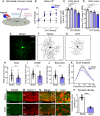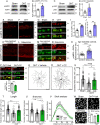AMPK hyperactivation promotes dendrite retraction, synaptic loss, and neuronal dysfunction in glaucoma
- PMID: 34187514
- PMCID: PMC8243567
- DOI: 10.1186/s13024-021-00466-z
AMPK hyperactivation promotes dendrite retraction, synaptic loss, and neuronal dysfunction in glaucoma
Abstract
Background: The maintenance of complex dendritic arbors and synaptic transmission are processes that require a substantial amount of energy. Bioenergetic decline is a prominent feature of chronic neurodegenerative diseases, yet the signaling mechanisms that link energy stress with neuronal dysfunction are poorly understood. Recent work has implicated energy deficits in glaucoma, and retinal ganglion cell (RGC) dendritic pathology and synapse disassembly are key features of ocular hypertension damage.
Results: We show that adenosine monophosphate-activated protein kinase (AMPK), a conserved energy biosensor, is strongly activated in RGC from mice with ocular hypertension and patients with primary open angle glaucoma. Our data demonstrate that AMPK triggers RGC dendrite retraction and synapse elimination. We show that the harmful effect of AMPK is exerted through inhibition of the mammalian target of rapamycin complex 1 (mTORC1). Attenuation of AMPK activity restores mTORC1 function and rescues dendrites and synaptic contacts. Strikingly, AMPK depletion promotes recovery of light-evoked retinal responses, improves axonal transport, and extends RGC survival.
Conclusions: This study identifies AMPK as a critical nexus between bioenergetic decline and RGC dysfunction during pressure-induced stress, and highlights the importance of targeting energy homeostasis in glaucoma and other neurodegenerative diseases.
Keywords: Adenosine monophosphate-activated protein kinase; Glaucoma; Mammalian target of rapamycin; Metabolic stress; Neurodegeneration.
Conflict of interest statement
The authors declare that they have no competing interests.
Figures





Similar articles
-
Retinal ganglion cell dendrite pathology and synapse loss: Implications for glaucoma.Prog Brain Res. 2015;220:199-216. doi: 10.1016/bs.pbr.2015.04.012. Epub 2015 Jun 30. Prog Brain Res. 2015. PMID: 26497792 Review.
-
Insulin signalling promotes dendrite and synapse regeneration and restores circuit function after axonal injury.Brain. 2018 Jul 1;141(7):1963-1980. doi: 10.1093/brain/awy142. Brain. 2018. PMID: 29931057 Free PMC article.
-
Insulin restores retinal ganglion cell functional connectivity and promotes visual recovery in glaucoma.Sci Adv. 2024 Aug 9;10(32):eadl5722. doi: 10.1126/sciadv.adl5722. Epub 2024 Aug 7. Sci Adv. 2024. PMID: 39110798 Free PMC article.
-
Selective Vulnerability of Specific Retinal Ganglion Cell Types and Synapses after Transient Ocular Hypertension.J Neurosci. 2016 Aug 31;36(35):9240-52. doi: 10.1523/JNEUROSCI.0940-16.2016. J Neurosci. 2016. PMID: 27581463 Free PMC article.
-
Dendritic and synaptic protection: is it enough to save the retinal ganglion cell body and axon?J Neuroophthalmol. 2008 Jun;28(2):144-54. doi: 10.1097/WNO.0b013e318177edf0. J Neuroophthalmol. 2008. PMID: 18562848 Review.
Cited by
-
TBK1 Knockdown Alleviates Axonal Transport Deficits in Retinal Ganglion Cells Via mTORC1 Activation in a Retinal Damage Mouse Model.Invest Ophthalmol Vis Sci. 2023 Jul 3;64(10):1. doi: 10.1167/iovs.64.10.1. Invest Ophthalmol Vis Sci. 2023. PMID: 37395713 Free PMC article.
-
bFGF-Chitosan "brain glue" promotes functional recovery after cortical ischemic stroke.Bioact Mater. 2025 Jan 2;46:386-405. doi: 10.1016/j.bioactmat.2024.12.017. eCollection 2025 Apr. Bioact Mater. 2025. PMID: 39850018 Free PMC article.
-
Retinal Ganglion Cells in a Dish: Current Strategies and Recommended Best Practices for Effective In Vitro Modeling of Development and Disease.Handb Exp Pharmacol. 2023;281:83-102. doi: 10.1007/164_2023_642. Handb Exp Pharmacol. 2023. PMID: 36907969 Free PMC article. Review.
-
Systemic Treatment with Pioglitazone Reverses Vision Loss in Preclinical Glaucoma Models.Biomolecules. 2022 Feb 9;12(2):281. doi: 10.3390/biom12020281. Biomolecules. 2022. PMID: 35204782 Free PMC article.
-
Effects of different anesthetic drugs on electroretinography in mice.Sci Rep. 2025 May 15;15(1):16930. doi: 10.1038/s41598-025-98924-x. Sci Rep. 2025. PMID: 40374951 Free PMC article.
References
-
- Harris JJ, Jolivet R, Attwell D. Synaptic energy use and supply. Neuron. 2012;75(5):762-77. 10.1016/j.neuron.2012.08.019. - PubMed
Publication types
MeSH terms
Substances
Grants and funding
LinkOut - more resources
Full Text Sources

